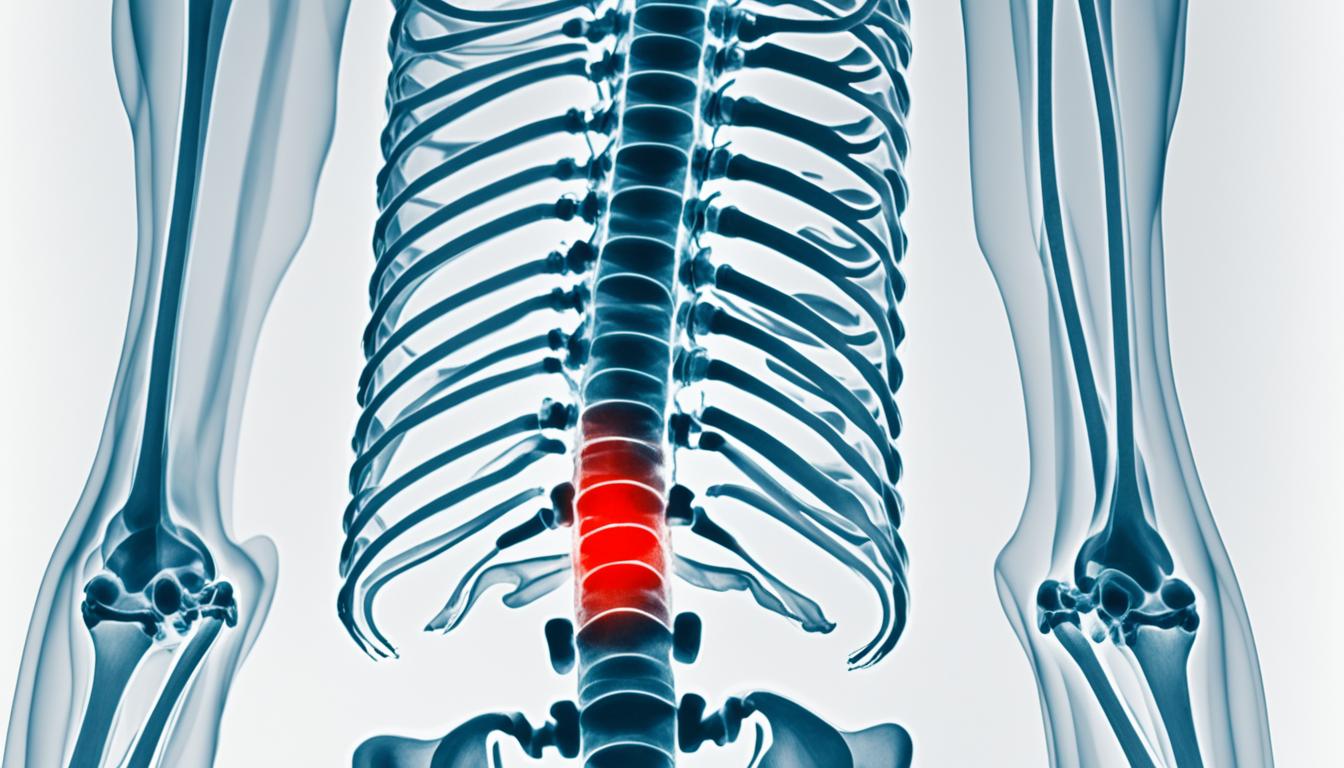Slipped disk disease is also called a herniated disc. It’s when the soft center of a spinal disc pokes through a crack in the tough outer layer. This causes a bulging or ruptured disc. It can result in back or neck pain, numbness, weakness, and pain that goes down the arms or legs.
Key Takeaways:
- Slipped disk disease, also known as herniated disc or spinal disc herniation, is a common condition that can cause pain and discomfort.
- A slipped disk occurs when the center of a spinal disc pushes through a crack in the outer layer, resulting in a bulging or ruptured disc.
- Symptoms of a slipped disk may include back or neck pain, numbness or tingling sensations, weakness, and radiating pain down the arms or legs.
- Causes of a slipped disk can include age-related degeneration, obesity, tobacco usage, trauma, and strenuous physical labor.
- Diagnosis of a slipped disk involves physical examination, medical history review, and imaging tests such as X-rays, CT scans, or MRI scans.
Slipped disk disease greatly affects life quality and daily life. It’s essential to know the symptoms and causes for proper treatment. For severe cases, stem cell therapy offers hope. It works by helping the affected disc heal and regenerate, which is different from standard treatments.
Causes and Risk Factors of Slipped Disk
Slipped disks, or herniated discs, often happen due to multiple reasons. The main cause is getting older. Over time, the discs in our spine lose their cushioning. This makes them more likely to herniate. This is a natural process. It affects everyone as they age, but not everyone will get degenerative disc disease.
Age isn’t the only factor, though. Being overweight is also a big risk. It stresses the spine and discs more. Another risk is smoking. Smoking harms how the body sends nutrients to the spinal discs. This can lead to their degeneration.
Injuries can cause herniated discs too. A fall, for instance, can put sudden pressure on your spine. It might lead to a herniated disc. Also, jobs that involve a lot of heavy lifting, repeating the same motions, or twisting the spine too much can up your risk.
There are also genetic and environmental elements at play. Knowing your family’s medical history can help you take steps to keep your spine healthy. It’s worth noting that age is the biggest factor for herniated discs.
Summary of Causes and Risk Factors for Slipped Disk:
| Causes | Risk Factors |
|---|---|
| Age-related degeneration of spinal discs | Obesity |
| Tobacco usage | |
| Trauma such as slip or fall | |
| Strenuous physical labor | |
| Genetic and environmental factors |
Learning about slipped disk causes and risks can help us be proactive to prevent it. It’s good to keep a healthy weight, not smoke, lift things the right way, and avoid accidents. Doing these things can keep your spine healthy.
Diagnosis and Treatment of Slipped Disk
Diagnosing a slipped disk starts with a thorough check-up. The doctor looks at your medical history. They might also order X-rays, CT scans, or MRI scans. These tests help find the slipped disk and see how bad it is.
Next, the doctor does a physical exam. They check your movement, reflexes, and muscle strength. This helps figure out if a slipped disk is causing your symptoms.
Your medical history is key. The doctor will ask about your pain, past injuries, and any related health issues. This info is vital for diagnosis.
Tests like X-rays show bone issues, MRI scans show soft tissue like disks. They’re used to confirm the slipped disk. CT scans give detailed spine images to figure out the problem’s size and location.
If the disk isn’t too severe, you might get treatments to avoid surgery. These include rest, physical therapy, or pain meds.
But, for more intense pain or if conservative methods fail, surgery could be needed. Operations like discectomy or spinal fusion can help in this case.
It’s worth noting, surgery isn’t needed by everyone with a slipped disk. Other treatments, like stem cell therapy, are also being explored. This cutting-edge therapy aims to help the body heal itself, offering hope for a future without such severe symptoms.
Stem Cell Therapy for Slipped Disk
Stem cell therapy is a new hope for those with slipped disks. It’s a step forward in regenerative medicine for spinal disc issues. This method uses stem cells to heal and regrow the disc, reducing pain and symptoms.
Here’s how it works: stem cells are injected into the damaged disc. They work to repair the tissue and relieve the patient’s pain. Studies have found this treatment very promising.
Yet, it’s crucial to realize that more research is needed. We still have much to learn about how well it works and its safety. Even so, it’s a ray of hope for people with slipped disks, offering an alternative to more invasive procedures.

